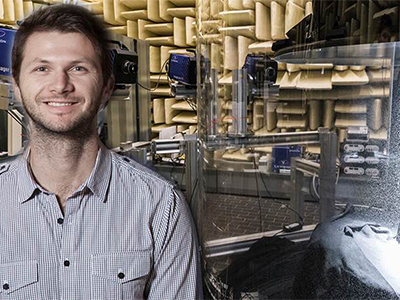World-leading experiments have direct application for Defence

In order to improve the performance of Defence platforms, Defence Science and Technology (DST) researchers have been analysing how aircraft, under-water and surface vehicles move through the air or water.
"When we can understand how these platforms perform in different flow-conditions, we can find ways to improve performance," Defence researcher Peter Manovski explains.
In recent years, a major step forward for the team has been the development of a world-leading Particle Image Velocimetry (PIV) system. PIV is a technique that allows the velocity-field of large fluid-flows to be captured.
"Synchronised cameras capture the movement of the tracer-particles at instances in time, and then software is used to determine their velocity," says Manovski.
"The result is a detailed map of the velocity-field around the object of interest."
Collaborating with world experts
Manovski recently returned from a DST International Fellowship at the German Aerospace Centre (DLR). Manovski worked alongside the world experts in flow diagnostics and these experts played a key role in the development of the Particle Image Velocimetry system.
Some potential Defence applications for this new technology include the analysis of highly turbulent flow-fields around fighter aircraft, the measurement of acoustic resonance inside a weapon bay, and the acoustic flow-field around a submarine.
Helium-filled soap bubbles deliver unique data
While at DLR, Manovski was involved in major experimental test campaigns. One experiment investigated the flow of a low-speed impinging jet. Small Helium-filled soap bubbles were used as the tracer particles used to seed the flow. High-powered and pulsed LEDs were used to illuminate the flow as six high speed cameras tracked the neutrally buoyant soap-bubbles.
The DLR Shake-The-Box algorithm, which provides unparalleled accuracy and spatial resolution of flow-fields, was then used to triangulate the position of the bubbles in three-dimensions as imaged by the cameras, and then reconstruct their track at each time step.
The algorithm computes the location of the bubbles in later time-steps and then uses a mathematical correction that "shakes" the predicted bubble positions to their real position. The result is a dramatic 10 to 50 speed-up in processing time compared to other volumetric techniques.
Manovski was able to apply the novel Shake-The-Box technique to track up to 190,000 bubbles, extracting velocity, acceleration and acoustic flow-field information.
"Each one of the 190,000 bubbles that was tracked in the flow can be considered as an individual velocity and acceleration sensor, which in combination allow to determine the 3D pressure distribution," Manovski explains.
"It is the equivalent of having 190,000 probes in the flow. This kind of information has never been available before."
In the second experiment the jet flow was much faster, 0.84 times the speed of sound. Manovski produced a software program to conduct averaging of the particle track data in very small cylindrical volumes. This provided a sub-pixel characterisation of the high-speed flow-field; this is a world-first.
This new particle tracking method is set to become an essential tool in the world of experimental aerodynamics, particularly as highly accurate volumetric flow measurements are needed to validate computational fluid dynamics (CFD) simulations.
Manovski's ground-breaking collaborative work with DLR has allowed him to start implementing these methods at DST.
"These world-leading experimental capabilities will have direct application for Defence, particularly for studying the complex acoustic flow-fields around submarines," Manovski says.
References published in relation to this work
Schanz D, Schröder A, Gesemann S (2016) Shake-The-Box: Lagrangian particle tracking at high particle image densities, Exp. Fluids 57:70.
Huhn F, Schanz D, Manovski P, Gesemann S, Schröder A, (2017) Time-resolved large-scale pressure fields of an impinging jet from dense Lagrangian particle tracking, Exp. Fluids (under review).
Manovski P, Novara, M., Depuru-Mohan, N.K., Geisler, R., Schanz, D., Agocs, J., and Schröder, A., (2017) 3D Lagrangian particle tracking of a high-subsonic jet using four-pulse Shake-The-Box, Particle Image Velocimetry: A practical Guide: Markus Raffel et al. (3rd edition expected release late 2017).

